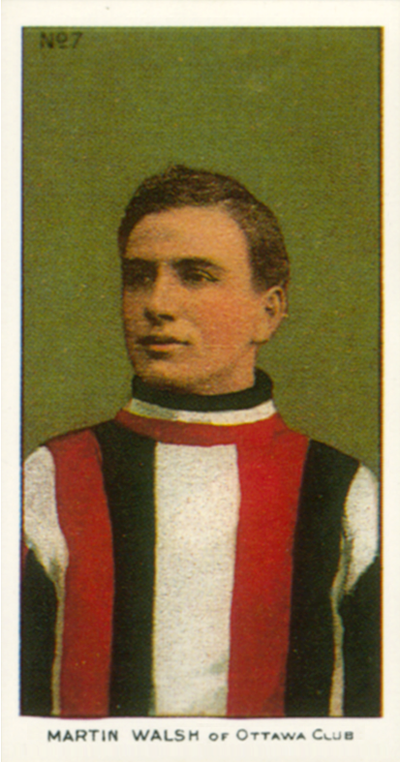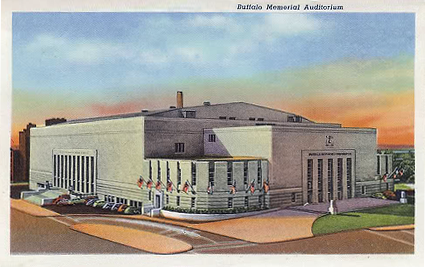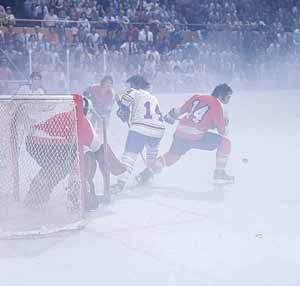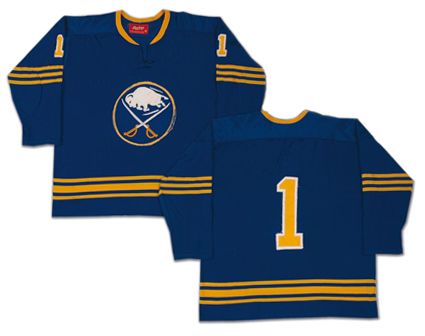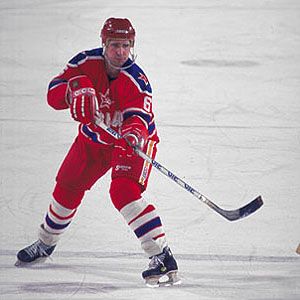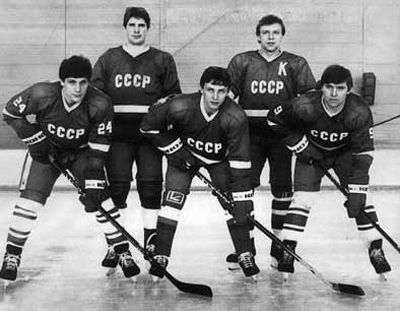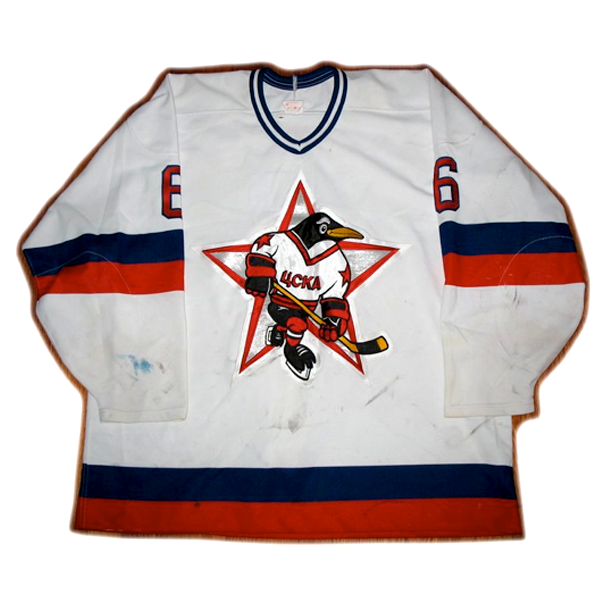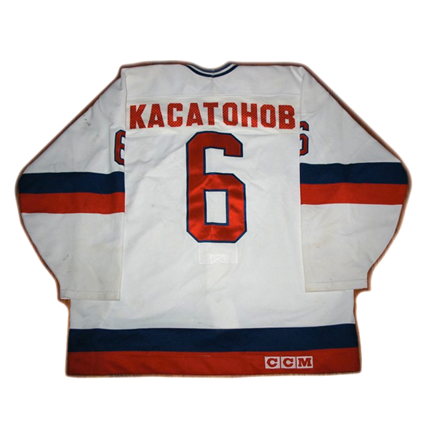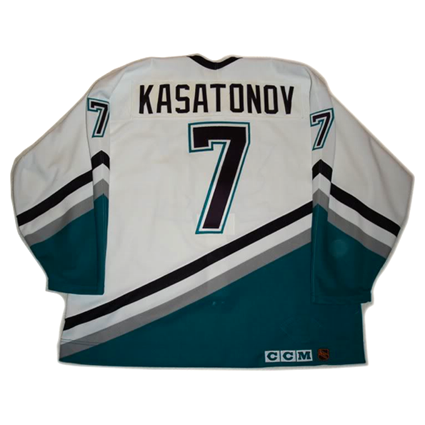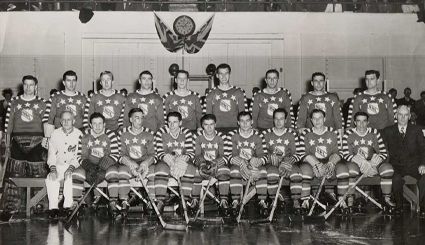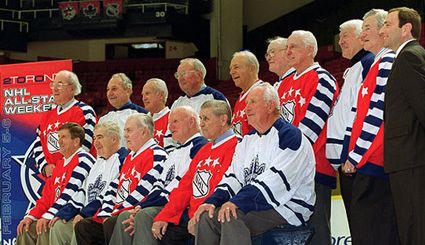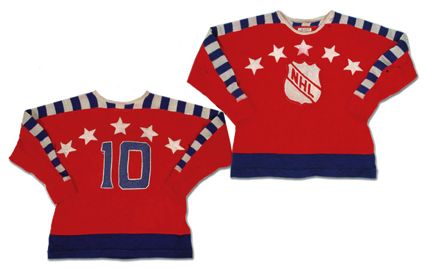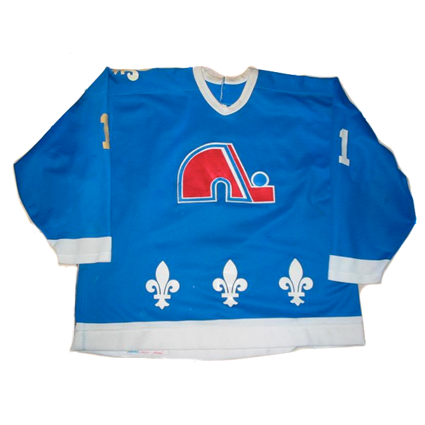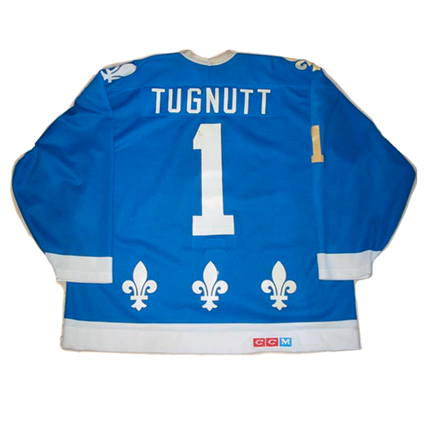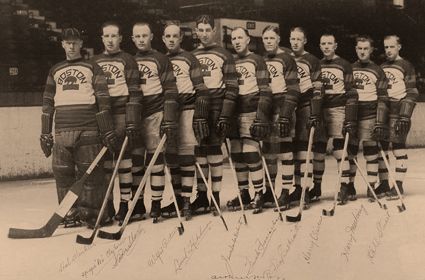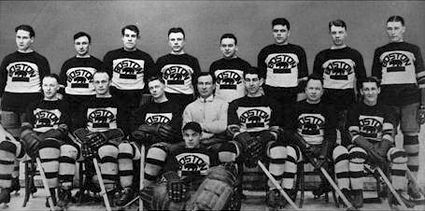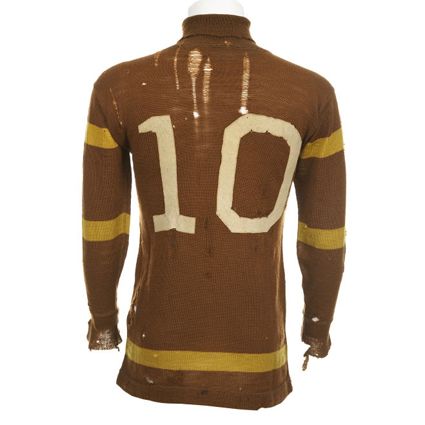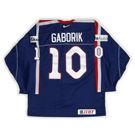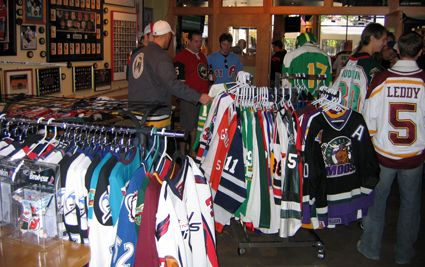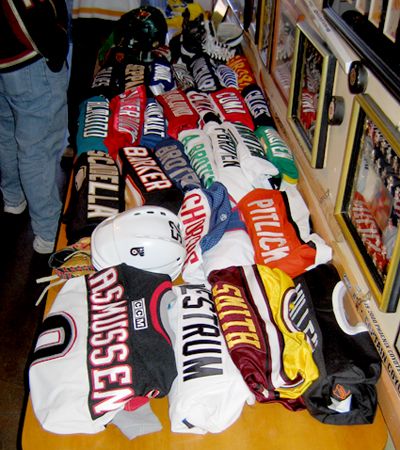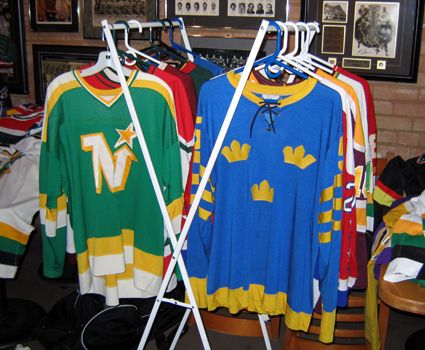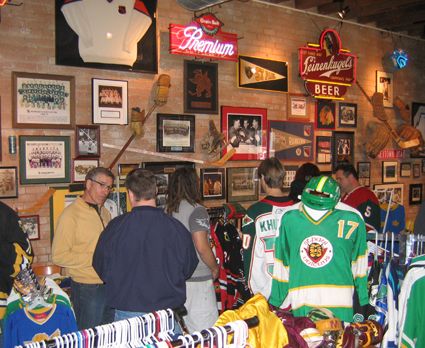Saturday, October 16, 2010
1909-10 Ottawa Senators Marty Walsh Jersey
Born on this date in 1883, Marty Walsh played in the Canadian Intercollegiate Hockey Union for Queen's University from 1902 through 1906, including a league championship in 1906 which led to a challenge for the Stanley Cup during which he scored four goals in two games versus the Ottawa Silver Seven.
Walsh turned professional in 1906-07 when he played for the Canadian Soo of the International Hockey League. Unfortunately, his season was limited to seven of 24 games due to a broken leg, but he gave a glimpse of his potential with four goals and five assists for nine points in limited action.
For the 1907-08 season Walsh moved back east to join the mighty Silver Seven, who had defended the Stanley Cup 11 times from March 1903 to March 1906. In his first season with Ottawa, Walsh made his presence known with 27 goals in nine games, including seven in one game against Montreal on March 7, 1908, to lead the league in scoring.
The following season Walsh again led the league in scoring with an astounding 42 goals in just 12 games, an average of 3 1/2 goals a game! The club, now known as the Senators, demolished the competition with a 10-2 mark while scoring 117 goals in their 12 games, quite nearly a ten goal per game average and no game with less than five. As Eastern Canada Hockey Association champions, the Senators became holders of the Stanley Cup.
As was often the case in the formative years of professional hockey, a dispute within the ECHA led to the Senators joining a brand new league for 1909-10, the Canadian Hockey Association. The league was a failure and Ottawa ended up playing just three league games as well as a pair of defenses of the Stanley Cup. Walsh scored nine goals in the two Senators CHA games he played and then six in the first game of the Senators defense of the cup against Galt.
When the CHA disbanded, Ottawa then became a member of the National Hockey Association for their schedule of games that season. Walsh came fourth in league scoring with 23 goals in 11 games as well as adding a pair of goals in a successful defense of the Stanley Cup against Edmonton of the Alberta Amateur Hockey Association. All told, Walsh scored 40 goals in 17 games that season but Ottawa had to relinquish the Stanley Cup to the NHA champion Montreal Wanderers.
Walsh had another stellar season in 1910-11 with 35 goals in 16 NHA contests to lead the league in scoring as the Senators won the league championship to regain possession of the Stanley Cup once more.
1911 Ottawa Senators - holders of the Stanley Cup
On March 13th, Galt once more challenged for the Stanley Cup and Walsh led the defense with three of the seven Ottawa goals to win 7-4.
Three days later Port Arthur had the misfortune to face an on-form Walsh, who scored ten goals in a 13-4 win for the Senators.
In his final season of 1911-12, Walsh scored 9 times in 12 games to close out his carer. Following his playing days, Walsh moved to Edmonton and fell ill, passing away just two years later.
He was inducted into the Hockey Hall of Fame in 1962.
Today's featured jersey is a 1909-10 Ottawa Senators Marty Walsh jersey. This unusual style features a departure from the signature Ottawa horizontal barberpole stripes, with the trademark red, black and white stripes running vertically before a return to the classic horizontal orientation for the remainder of the club's existence until 1934.
Labels:
Ottawa Senators,
Walsh Marty
Friday, October 15, 2010
1970-71 Buffalo Sabres Roger Crozier Jersey
The Buffalo Sabres were granted an NHL franchise in December of 1969 to begin play in the 1970-71 season. Punch Imlach was hired to build the team and immediately set out to assemble a scouting staff for the upcoming draft six months later.
On June 10, 1970, the Sabres and fellow expansion club the Vancouver Canucks participated in the expansion draft, which Imlach said "wasn't a very enticing prospect", as the existing 12 clubs could protect fifteen players plus two goalies, meaning the best the Sabres could hope for was the 16th best player from any club. To make matters worse, once a team lost a player, they could protect another, which meant the Sabres and Canucks would then be choosing the 18th best player at best. In addition, first-year players were exempt as well. Montreal, for an extreme example, was able to protect fifteen players and two goalies, plus an additional 12 players and Boston was in a position to protect eight additional beyond the prescribed 15, leaving nothing but scraps for the Sabres and Canucks in the first phase of attempting to put a respectable team on the ice.
Thus, their hopes of getting some noteworthy talent focused on the Amateur Draft held the next day. There was still the matter of deciding if Buffalo or Vancouver would have the first pick, which was usually decided by a coin toss, but Imlach explains in his book "Heaven and Hell in the NHL",
"For some reason, perhaps because it made better television, the NHL substituted a big jeezly wheel, the kind you see on the midway. It was numbered one to twelve. I won a toss to see who picked what numbers for the main spin. I chose the top ones. There was a hell of a crowd in the ballroom at the Queen Elizabeth Hotel, everyone in hockey there. When the first spin of the wheel stopped at eight, I had won first choice in the expansion draft. Everybody at our table cheered. But now came the big one."Clarence Campbell spun the wheel. When it stopped, he looked at the winning number and announced "Number one! Vancouver wins first choice in the amateur draft!"But I was on my feet and so was everybody at our table, pointing and yelling, "Eleven! Eleven!"Clarence took another look. The digits in the double figures were one above the other.It's always amused me that Clarence didn't say, "I've made a mistake." He said, "There has been a mistake. The winning number is eleven..." the rest was drowned out in the wild uproar, not only at our table, but through the room, with only Vancouver and it's supporters remaining quiet. Even glum."
Prior to the expansion and amateur drafts, the Sabres had acquired a few players, but no one anyone was interested in trading for. But now in position to pick first in the expansion draft, Sid Abel of the Detroit Red Wings approached Inlach with a proposal. Abel was coveting Tom Webster, a 21 year old right winger who the Bruins had left unprotected. Imlach continues,
"But this night when [Abel] saw me, it was only a few hours after I'd won first choice in the expansion draft. He hooked his arm though mine and said so the guys with me could hear, "Come with me, Punch. I want to give you something.""I'll bet you do!" I said.We walked to a quite corner."Look, you know Tom Webster?""Yeah." The protected lists were out and Webster was not protected. Detroit wanted him, badly. Obviously."If you'll pick Webster first, we'll trade you Roger Crozier for him," Abel said.Music! Whatever else we got in the draft, we just had to come up with an NHL goalkeeper. But Crozier was beyond my wildest dreams. He had won the rookie award in his first full year, the Conn Smythe Trophy as the most valuable player in the playoffs a year later and had a low 2.65 goals against average in the season just ended. But he wasn't happy in Detroit an dthey though he was sick too much. That's when you can get a guy."You got a deal!" I told Abel.
With the goaltending position now addressed and his plan to select Gilbert Perreault in the amateur draft lined up, Imlach took defensemen with four of his next five picks before going after the best skaters and scorers he could get in an effort to provide the public in Buffalo an exciting as possible product.
The opportunity to provide the public in Buffalo that product finally arrived on this date in 1970, when the Sabres played their first ever home game in the Buffalo Memorial Auditorium.
"We hadn't been able to get the balcony built for that season. We didn't even have our own dressing room," Imlach recalled.
The Sabres had already won their debut game on the road in Pittsburgh 2-1 and lost in New York to the Rangers 3-0 before returning home to face the Montreal Canadiens.
"They played that funny game where they don't let you have the puck. I remember before the game, at the reception the Knoxes threw for opening night, somebody said that everybody there would do anything they could to help the Knoxes, except play goal. The game that night show how true that was. Roger Crozier was just magnificent in our goal, but they outshot us 44-14 and beat us 3-0."
While it may have been the Sabres first game in "The Aud", it was far from the first event ever held there, as Memorial Auditorium opened thirty years and a day earlier on October 14, 1940 and it's first tenant was the AHL's Buffalo Bisons hockey team until the arrival of the Sabres in 1970. Also calling The Aud home beginning in 1970 were the Buffalo Braves of the NBA as well as indoor lacrosse, soccer and roller hockey teams and the usual concerts, rodeos and circuses.
To accomodate the arrival of the Sabres and Braves, the roof of the arena was raised 24 feet to make room for a new upper level of seating which raised the capacity for hockey from 12,280 to 15,858. Later renovations pushed that total to 16,433 seats and air conditioning was added in 1990 to try to modernize the building until a new arena could be funded and constructed.
The air conditioning would also prevent another occurrence of an incident in 1975 when a playoff game in the spring was plagued by a thick fog forming on the ice as a result of a sold out building and the warm weather outside heating up the building too much.
"The Fog Game" during the 1975 playoffs
The Aud remained in use until 1996 and was not demolished until 2009. For a fascinating look inside the abandoned Buffalo Memorial Auditorium prior to it's demolition, click here.
Today's featured jersey is a 1970-71 Buffalo Sabres Roger Crozier jersey. The original Sabres jerseys featured a lace-up collar and no names on the back until mandated by the league in 1977. This style lasted as long as the Sabres played in The Aud, and were replaced by a new buffalo head logo as well as a radical change in color scheme from blue and gold to black and red with the move to their new arena.
Crozier had actually played for the Buffalo Bisons in the AHL prior to his making the jump to the NHL with the Red Wings in 1963. Following his trade to the expansion Sabres, he would return to Buffalo and The Aud for six seasons before closing out his career with a brief stint of three games with the Washington Capitals in 1976. He was the first member inducted in the Buffalo Sabres Hall of Fame in 1980.
This video tribute to the Buffalo Memorial Auditorium includes footage of the game winning goal for the Sabres from "The Fog Game" and Wayne Gretzky breaking the single season goal scoring record of 76.
Our final video today is the final minute of the last game ever played at The Aud.
Labels:
Buffalo Sabres,
Crozier Roger
Thursday, October 14, 2010
1996-97 CSKA Moscow Alexei Kasatonov Jersey
Born on this date in 1959 in what was then known as Leningrad in the Soviet Union, Alexei Kasatononv played seven seasons in the NHL following a 15 year career in the Soviet Elite League.
His career began with SKA Leningrad in 1976-77 for two seasons after which the defenseman moved to CSKA Moscow, known more commonly to North American's as the Soviet Central Red Army Hockey Club, where all the finest players in the Soviet Union migrated towards.
Kasatonov played for CSKA Moscow from the 1978-79 season through 1989-90, winning 11 consecutive Soviet League Championships from 1979 to 1989 and 12 consecutive European Cups. While a member of Red Army, he scored a high of 18 goals in 1984-85 and a best 27 assists and 39 points in 1981-82 in a league where the season was between 40 and 50 games long.
Kasatonov with CSKA Moscow
As a member of CSKA Moscow, he was also a long-time member of the Soviet National Team, which naturally was primarily comprised of players from the most dominant club in the land. While playing for his country, Kasatonov won gold medals at the World Championships in 1981, 1982, 1983, 1986 and 1989 and a silver medal in the 1980 and gold medals in both the 1984 and 1988 Olympics as a member of the famed "Green Unit" with Slava Fetisov, Sergei Makarov, Igor Larionov and Vladimir Krutov.
The "Green Unit"
Following the conclusion of the 1989-90 Soviet season, Kasatonov was allowed to join the New Jersey Devils of the NHL, where he would be reunited with former Red Army teammate Fetisov for the second half of the NHL sechedule. Kasatonov's first NHL season comprised 39 games in which he scored 6 goals and 21 points while acclimating to life in North America, which was often a difficult proposition for Soviet players in those days.
The NHL game agreed with Kasatonov though, and he scored 41 and 40 points the next two seasons while playing 78 and 76 games, with 14 additional playoff games added on, for a total of 168 over two seasons, when compared to the perhaps 120 he was accustomed to. He was limited to 64 games and saw his point total drop precipitously to just 17 in 1992-93, which saw the 34 year old left unprotected in the 1993 NHL Expansion Draft and subsequently claimed by the Mighty Ducks of Anaheim.
Kasatonov played 55 games for the Mighty Ducks and appear in the 1994 NHL All-Star Game prior to being traded to the St. Louis Blues in late March of 1994 wher he would play just 8 games with the Blues.
He returned to CSKA Moscow for nine games during the work stoppage of 1994, and once the NHL season began, he began play with the Boston Bruins, with whom he had signed as a free agent. The following season Kasatonov played 19 games with Boston and 16 games with Providence of the AHL.
He returned to Russia for one last season with CSKA Moscow in 1996-97 before his retirement as a professional.
HIs final NHL totals were 38 goals and 122 assists for 160 points in 383 games, and combined, he scored 200 goals and 627 points in 1128 games.
Kasatonov was named a "Honored Master of Sport" in Russia and was inducted into the IIHF Hall of Fame in 2009.
Kasatonov's induction to the IIHF Hall of Fame in 2009
Today's featured jersey is a 1996-97 CSKA Moscow Alexei Kasatonov jersey. This jersey is from Kasatonov's final season when he returned to Russia following the conclusion of his NHL career. Note the name on the back in Cyrillic lettering.
After the collapse of the Soviet Union in 1991, the government funding of the team disappeared and the Pittsburgh Penguins of the NHL entered into a business partnership with the club, which was often referred to as "the Russian Penguins" during this time period as a penguin was integrated into the club's identity. The deal with Pittsburgh, who were to run the club's arena and hoped to benefit by having better access to new Russian talent, was short lived due to, among other things, interference by the Russian Mafia, who liked to attend games while sitting in the corporate sponsor's "super boxes" after kicking them out behind the authority of a sawed off shotgun!
Bonus Jersey: Today's bonus jersey is a 1993-94 Mighty Ducks of Anaheim Alexei Kasatonov jersey as worn during the Mighty Ducks inaugural season in which Kasatonov played 55 games before being traded to the St. Louis Blues.
In today's video segment, a look at Kasatonov's career and his life after retiring from hockey, which includes coaching hockey in America.
Here, Kasatonov discusses the "Miracle on Ice" 25 years later.
Finally, while playing for the Soviet National Team, Kasatonov scores against Grant Fuhr and the NHL All-Stars during Rendez-Vous '87.
Wednesday, October 13, 2010
1947 NHL All-Star Game Edgar Laprade Jersey
While there had been three benefit and memorial games held throughout the 1930's, the first official NHL All-Star Game took place on this date in 1947 at Maple Leaf Gardens in Toronto.
From 1947 through 1965 the game took place just prior to the start of the season, rather than it's current mid-season location adopted in 1967. The original format for the game, which featured the defending Stanley Cup champions taking on a team comprised of players from the other five clubs, was necessitated by the limited number of teams in the NHL at the time.
In honor of the occasion, the wire fencing surrounding the rink was replaced by glass and a new tradition was started where they defending champions were showered with gifts from sponsors and given lifetime passes to Maple Leaf Gardens. It didn't hurt that the defending champions that season were the Maple Leafs!
The 1947 Stanley Cup Champion Toronto Maple Leafs
The All-Stars were comprised of four members of the Boston Bruins and Montreal Canadiens and three each from the Detroit Red Wings, Chicago Black Hawks and New York Rangers
The 1947 NHL All-Star Team
Harry Watson of Toronto opened the scoring at 12:29 of the first period and Bill Ezinicki extended their lead to 2-0 with assists from Syl Apps and Watson at 1:03 of the second.
Chicago's Max Bentley kept the All-Stars in the game with a response at 4:39 from Ken Reardon of Montreal only to have Apps restore the two goal margin just 22 seconds later on Watson's second assist of the period. Grant Warwick of the Rangers took the Toronto lead down to one when he scored at 9:25 of the second from Rangers teammate Edgar Laprade and Reardon.
The Canadiens' Maurice Richard's unassisted goal just 28 seconds into the third evened the score at 3-3 before Max Bentley's brother Doug Bentley, also from Chicago, put the All-Stars ahead to stay with his goal from Boston's Milt Schmidt and Richard at the 1:26 mark.
The remainder of the game would be played scoreless, giving Frank Brimsek of the Bruin's the win in goal while Turk Broda took the loss for the Maple Leafs in front of 14,169 fans.
The reunion of the original All-Star Game players in 2000 at
the 50th NHL All-Star Game, also held in Toronto
Today's featured jersey is a 1947 NHL All-Star Edgar Laprade jersey. The All-Stars wore these red sweaters while Toronto wore their white ones. This style of All-Star jersey would remain in use through 1954 until a change in NHL policy saw the home teams now wearing their dark jerseys, which led to a change to a white version of this jersey for the All-Stars until a new design was finally adopted in 1960. This style jersey was revived for the 1993 NHL All-Star Game in Philadelphia during the NHL's 75th Anniversary season.
Laprade spent his entire NHL career with the Rangers from 1945 to 1955, which included winning the Calder Trophy in 1946 and the Lady Byng Trophy in 1950. His career highs were 22 goals in 1949-50 and 34 assists and 47 points in 1947-48. His 34 assists were third in the league that season. He led the Rangers in scoring in 1949-50 and was named to the Hockey Hall of Fame in 1993.
Labels:
Laprade Edgar,
NHL All-Star Game
Tuesday, October 12, 2010
1990-91 Quebec Nordiques Ron Tugnutt Jersey
Ron Tugnutt set a record on this date in 2002, when he became the first goaltender to play for eight different teams when he made his Dallas Stars debut with a 5-2 win over the Phoenix Coyotes.
Tugnutt's long journey began back in Peterborough, Ontario while as a member of the Petes in the Ontario Hockey League, he was drafted 81st overall in the 1986 NHL Entry Draft after going 18-7 with the Petes that year. One more season with Peterborough ensued prior to joining the Fredericton Express of the AHL in 1987-88. He then made his NHL debut with the Nordiques on December 29, 1987 with a 5-1 win over the Buffalo Sabres. In all, he would play in 6 games with the Nordiuqes that season.
In 1988-89, he would split time between the Halifax Citadels (24 games) and the Nordiques (26 games), going 10-10-3 with Quebec, not a bad feat considering the Nordiques other goalies combined to go 17-36-4 for the worst team in the league.
For an encore, the Nordiques got worse the following season. Much worse. While they scored 61 points the year before, the 1989-90 Nordiques went 12-61-7 for just 31 points, 33 points less than the next worst team! Needless to day Tugnutt's numbers took a beating that year and his final win-loss record was 5-24-3 as, searching for answers the Nordiques used no less than seven different goaltenders that season, with the other six combining for 7 wins.
The Nordiques "improved" to 46 points in the 1990-91 standings and 16 wins, 12 of which were by Tugnutt, while four other goalies combined for 4. In one memorable game, he made 70 saves in a 3-3 overtime tie against the Bruins.
After suffering through another season with the terrible Nordiques, Tugnutt was paroled in March of 1992 when he was traded to the Edmonton Oilers late in the season. While he arrived just after the conclusion of the Oilers dynasty, the Oilers were still a contender and made the conference finals, giving Tugnutt his first taste of postseason play.
Unfortunately, the 1992-93 season would see the Oilers miss the NHL playoffs for the first time in their 14 year NHL history.
He was left unprotected by the Oilers that summer and was claimed by the Mighty Ducks of Anaheim in the 1993 NHL Expansion Draft, ensuring that he would once more end the season without his name being engraved on the Stanley Cup. While the Mighty Ducks did not qualify for the playoffs in their first season, favorable rules allowed them to field a respectable squad and the club won 33 games, 10 of which were by Tugnutt prior to him being traded to the Montreal Canadiens in February of that season.
The 1994-95 season was a lost one for Tugnutt, as he appeared in only 7 games for Montreal, as the Canadiens number one starter Patrick Roy played in the vast majority of games in the strike shortened season.
Although he was signed by the Washington Capitals organization prior to the 1995-96 season, he would never appear in a game for the Capitals as he would spend the entire year back in the AHL with the Portland Pirates where he set a career high with 58 games played.
Happy to have a chance to return to the NHL, Tugnutt signed with the Ottawa Senators, his 5th NHL club, despite the fact Ottawa had yet to make the playoffs in their four year history. Splitting time with Damian Rhodes that season, the Senators earned their first playoff berth and Tugnutt set a personal NHL best with 17 wins and finally found some stability in the NHL.
The next two seasons Tugnutt would appear in 43 and then 44 games while in tandem with Rhodes and raised his best win total up to 22 along with a standout 1.79 goals against average in 1998-99, which earned him some consideration in the Vezina Trophy balloting in which he placed fifth and his only appearance in an NHL All-Star Game that season.
There were changes for 1999-00, as Tugnutt now shared time with Patrick Lalime following the departure of Rhodes, and despite starting the bulk of the games for the Senators, he was sent to the Pittsburgh Penguins at the trade deadline. In Pittsburgh, he got the most playoff experience of his career, with 11 games in the 2000 postseason.
With his contract now expired, Tugnutt signed as a free agent with the expansion Columbus Blue Jackets for the 2000-01 season and set an NHL high with 53 games played as well as a respectable 22-25-5 mark for the first year club to set a record for wins with a first year expansion team.
After one more season with the Blue Jackets, Tugnutt was traded to the Dallas Stars for the 2002-03 season and would become the first NHL goalie to play for eight different teams when he made his first start for the Stars on this date in 2002. After one more season, in which he played 12 games for the Stars and 5 for the Utah Grizzlies in the AHL, Tugnutt found himself unsigned following the season lost to the NHL lockout and retired as a player.
His final NHL totals were 537 games played, 186 wins, 239 losses and 62 ties while playing on some truly horrible clubs and a series of expansion teams.
Internationally, Tugnutt played for Team Canada in the World Championships twice, in 1993 and 1998.
Today's featured jersey is a 1990-91 Quebec Nordiques Ron Tugnutt jersey. from the season in which he had his 70 save performance against the Bruins. The Nordiques were the last NHL club to use heat sealed material for their names and numbers, which shown here is prone to discolorization and long-term cracking and peeling, making them a challenge for collectors of game worn jerseys to keep in good condition.
All told, Tugnutt would wear 18 different jerseys during his NHL career, including two alternate styles while with Ottawa and Dallas.
Today's video section highlights the 70 saves Tugnutt made in one game versus the Boston Bruins in 1991.
Here is an interview with Tugnutt following the conclusion of his career.
While we normally avoid "slideshow" videos, this look at Tugnutt's career includes enough video clips and is a very nice retrospective on his career that we are pleased to bring it to you today.
Labels:
Quebec Nordiques,
Tugnutt
Monday, October 11, 2010
1924-25 Boston Bruins George Redding Jersey
On this date in 1924, the Boston Bruins officially received their NHL franchise, which made them the first club in the league located in the United States and, with the addition of the Montreal Maroons, brought the NHL up to six member clubs.
Charles Adams was taken by professional hockey after having attended the 1924 Stanley Cup Finals between the NHL's Montreal Canadiens and the Calgary Tigers of the WCHL.
His first order of business was to hire Art Ross as his new club's general manager, a post he would remain in for 30 years. It was Ross who coined the name "Bruins" after being challenged by Adams to come up with a name for the franchise of an animal that would represent speed, agility and cunning, while the club's original colors of brown and yellow were taken from Adams grocery store chain, First National Stores.
The Bruins played their first game on December 1, 1924 against their fellow expansion brothers that season, the Maroons, with the Bruins prevailing 2-1. The opening night victory flattered to deceive, as the Bruins would win just five more games that season on their way to a last place finish and a 6-24-0 record. Jimmy Herberts led the team in scoring by a wide margin, with is 17 goals in 30 games accounting for 35% of the Bruins 49 goals that season. His 22 points far outdistanced the next player who managed a paltry 8!
The Bruins began life in the Boston Arena for the first four years of their existence prior to moving into their long time home, the Boston Garden, while the Boston Arena would become the property of Northeastern University and, while renamed the Matthews Arena in 1982, it remains the oldest surviving indoor ice arena still in use in the world. While the Bruins moved out in 1928, professional hockey would return in 1972 with the arrival of the New England Whalers of the upstart World Hockey Association for games during their inaugural season prior to moving to Hartford, Connecticut.
The Bruins improved during their second season 0f 1925-26 in the now seven team NHL, but still finished outside the playoffs by but a single point despite their winning record of 17-15-4. Carson Cooper, with 28 goals, and Herberts, with 26, tied for the team scoring lead of 31 points.
1925-26 Boston Bruins
In 1926-27, the NHL divided itself into two divisions, with the Bruins in the new "American" division, with their success having opened the floodgates of the United States market with teams now in New York, with both the Rangers and Americans, Chicago, Pittsburgh and Detroit. The Bruins came second in the division behind the Rangers with a 21-20-3 record, led by Harry Oliver's 18 goals and 24 points. A new arrival to the Bruins roster would come in the from of the legendary Eddie Shore, a rough and tough future Hall of Famer who would play for the club until 1940.
1926-27 Boston Bruins
In the playoffs for the first time, the Bruins would defeat the Chicago Black Hawks 6-1 and 4-4 to win their two-game, total-goal series 10-5. Playing the same format, they would eliminate the Rangers after a scoreless tie in Boston with a 3-1 win on the road in New York to advance to the Stanley Cup Finals, the first contested by two NHL clubs.
The finals were a best-of-five versus the Ottawa Senators, however the first game was played to a scoreless tie. Ottawa won 3-1 before another tie, this time 1-1. Ottawa wrapped up the championship with another 3-1 win, taking the best-of-five by the unusual margin of 2-0-2.
The Bruins captured their first division title in 1927-28 with 20 wins, 13 losses and 11 ties as Oliver again led the club in scoring with 18 points, one more than defenseman Shore's 17. Another legendary Bruin Dit Clapper would join the club that season and remain with the Bruins for 20 years. The Rangers got their revenge and knocked the Bruins out of the playoffs with a 1-1 draw and a 4-1 win in Boston.
The Bruins again won the American Division in 1928-29 with a 26-13-5 record which included going undefeated for all of January (11-0-2). Oliver remained in his familiar place atop the scoring table with 17 goals and 23 points in 43 games.
Their division title earned them a first round bye in the playoffs. Tiny Thompson in goal shut out the Montreal Canadiens 1-0 and again 1-0 in the first two games and the Bruins closed out the series with a 3-2 win.
Awaiting them in the finals were the Rangers, and the Bruins dispatched them with a 2-0 win at home followed by a 2-1 win in New York to win the first Stanley Cup in franchise history as they became the last team until 1952 to sweep all their playoff games.
The Stanley Cup Champion 1928-29 Boston Bruins
The Bruins would return to the finals the following season but come up short. They would win Stanley Cups again in 1939 and 1941, but then suffer a drought which would last 29 years, including a dismal run where they would miss the playoffs eight consecutive seasons beginning in 1960 and finish last six out of seven seasons from 1961 to 1967, making their championship just three seasons later in 1970 all the more remarkable.
Today's featured jersey is a 1924-25 Boston Bruins George Redding jersey from the Bruins very first season. This jersey style was used for only one season and sold at auction for $27,000 in April, 2009. It is believed to be the only surviving jersey from the Bruins inaugural season, making it a truly unique item and an incredibly significant piece of memorabilia from such a historic franchise and one of the most exciting jerseys we have ever featured here at Third String Goalie.
Redding, a defenseman, would play 35 games for the Bruins over their first two seasons, scoring 3 goals and 2 assists, all in 1924-25, and would play six more seasons of hockey in lower leagues, making stops in Boston, London, Ontario, Minneapolis and Buffalo.
Our video section today is a look back at the history of the Boston Bruins franchise.
Labels:
Boston Bruins
Sunday, October 10, 2010
10/10/10
Since today is 10/10/10, we couldn't resist posting the following jerseys.
And in keeping with the 10/10/10 theme of the day, our 3 favorite Top 10 videos of all time.
2010 Minnesota Hockey Collectors Expo Report
Last week we attended the 2010 Minnesota Hockey Collectors Expo and saw some amazing jerseys and had some great conversations with fellow hockey jersey fans. Aside from the collector's who came to share their collections, former Minnesota North Stars Brad Maxwell, Tom Younghans and Gordie Roberts were in attendance this year, as was Minnesota Wild team historian Roger Godin.
Here are some photos from this year's event, which was the 9th annual one at Tom Reid's Hockey City Pub.
Above is the impressive Ben Clymer collection on the left and Kyle Oen's Minnesota themed collection on the right. Collecting one player, such as Clymer can be a challenge when they make multiple stops in the NHL and AHL, but that challenge increases exponentially when a player extends his career by playing in Europe, so this collection was all the more impressive with the addition of game worn jerseys from the German DEL.
Kyle brought a sampling of his game worn Minnesota high school jersey collection that rivals the one on display at the Xcel Energy Center, as well as other Minnesota based teams.
John Lindberg's take on a Minnesota theme. Where Kyle collects teams from Minnesota, John is more about former Gophers NHL jerseys as well as Minnesota Wild prospects jerseys before they reach the NHL.
Can't make it to the Hockey Hall of Fame in Toronto? Then having the opportunity to see Jon Bakke's collection of vintage jerseys with an international flavor can save you the trip. That's not just an old Sweden jersey either, it's Borje Salming's jersey! John can be easily spotted at Minnesota Wild games wearing his rotating collection of gamers, as he doesn't just hang them in a closet, he wears his regularly to Wild games.
Here are two more collections, which come at the hobby from different directions. Chris Groth (hanging on the left) just collects what catches his eye, although with a Minnesota influence, such as Mikko Koivu's game worn retro Finland jersey worn for one game of the 2008 World Championship, but his Alexander Ovechkin game worn jersey was certainly an Expo highlight.
The collection folded on the the table on the right was a very interesting collection of vintage NHL jerseys, mainly the 1980's and 1990's, from our favorite period of NHL jerseys and were terrific to look at and talk about.
Here was our contribution to the proceedings, closer to the camera were our jerseys worn in the movie "Miracle" and our game worn international jerseys from places such as East Germany, Holland, Iceland, Japan, Poland and even Spain as well as the more traditional countries like Canada, the Czech Republic and Russia. We also brought our Minnesota Twins baseball gamers on the far side of the rack.
The walls of Tom Reid's are just dripping with hockey memorabilia and create the perfect environment to hold such an event.
Finally, the event organizer Dave Frechette, without whom the Expo would not exist. Dave's collection focuses primarily on Minnesota Wild players jerseys, primarily before they joined the Wild, or at least non-Wild jerseys. Examples in his collection are Wild prospects college and junior team jerseys, European born players European club teams, Wild coaches sweaters from their NHL playing days, Wild players previous NHL team's jerseys and Wild players jerseys worn when they played for their national teams, such as Mikko Koivu's Team Finland jerseys.
How he is consistently able to track down jerseys from such a wide variety of sources is one of the more impressive things to take in at the Expo. He also has an appreciation of hockey history, as evidenced by the rare and wonderful Minnesota Fighting Saints WHA jersey seen here as well as his North Stars game worn jersey he is wearing.
Look for an announcement on the gameworn.net forums or this blog for details of next year's gathering in early October 2011, which will be the 10th annual occurrence of this can't miss event!
Labels:
Minnesota Hockey Collectors Expo
Subscribe to:
Comments (Atom)


